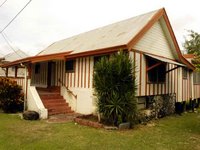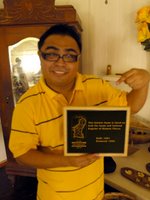 Hafa Adai from Guam! Today was a full day for me since I’m on a familiarization tour of Guam courtesy of the Guam Visitors Bureau (GVB) and Continental Airlines. Have tons of work to do here for Pilmap Travel & Leisure. So watch out for the December 15 issue.
Hafa Adai from Guam! Today was a full day for me since I’m on a familiarization tour of Guam courtesy of the Guam Visitors Bureau (GVB) and Continental Airlines. Have tons of work to do here for Pilmap Travel & Leisure. So watch out for the December 15 issue.I left Manila yesterday night at 11 p.m. I was at the airport early since I had to get my ticket at the Continental office at the 4th floor of NAIA. Good thing we were given invitations to the MIASCOR Lounge so I was able to relax a bit, check my mail while waiting, eat some dinner and drink a few glasses of red wine. The rest of the group had left the night before. And last night, only myself and Probe Team host Cheche Lazaro were on our way to Guam. I got to chat with her since we were seatmates as well on the plane.
 We arrived in Guam at 4:20 a.m. which is two hours ahead of Manila time. That meant we had less than three hours of sleep! Good thing our call time for the day was still at 9:30 a.m. so we had time to sleep some more before we buckled down to work.
We arrived in Guam at 4:20 a.m. which is two hours ahead of Manila time. That meant we had less than three hours of sleep! Good thing our call time for the day was still at 9:30 a.m. so we had time to sleep some more before we buckled down to work.The group was billeted at the Royal Orchid Hotel, a four-star hotel in Tumon which is quite near the airport. The rooms are great. It was funny too because the bathroom area is as big as the sleeping area since it had a dressing room, etc. And you could slide the bathroom windows so that you could watch TV while you’re in the tub.
I was up at 8:45 a.m., took a quick shower and went straight down for buffet breakfast at the Brooklyn Café. Then we were off.
 Our first stop was the Gef Pa’go Chamorro Cultural Village in Inarajan were we were given an introduction to the Chamorro way of life. There were several huts which featured various aspects of Chamorro culture such as salt making, rope twining, katupat weaving, etc. They charged US$10 per person.
Our first stop was the Gef Pa’go Chamorro Cultural Village in Inarajan were we were given an introduction to the Chamorro way of life. There were several huts which featured various aspects of Chamorro culture such as salt making, rope twining, katupat weaving, etc. They charged US$10 per person. The village, just a few huts and nothing fancy, was quite ordinary. But you learned a lot since the experience was hands-on. Imagine, we could do something like this in the Philippines such as in the Cordilleras or in Mindanao. And it could help preserve the culture since the income from tourism would encourage the indigenous communities to preserve and showcase their culture.
The village, just a few huts and nothing fancy, was quite ordinary. But you learned a lot since the experience was hands-on. Imagine, we could do something like this in the Philippines such as in the Cordilleras or in Mindanao. And it could help preserve the culture since the income from tourism would encourage the indigenous communities to preserve and showcase their culture. From the village, we walked towards one of the old houses of the village. You could see how much they value their heritage since, for Philippine standards, this was just an ordinary old house. Yet it was listed in the registry of heritage houses both in Guam and the United States because it represents the common folk, the Chamorro people.
From the village, we walked towards one of the old houses of the village. You could see how much they value their heritage since, for Philippine standards, this was just an ordinary old house. Yet it was listed in the registry of heritage houses both in Guam and the United States because it represents the common folk, the Chamorro people.In the Philippines, commoners’ houses would most probably not be considered as heritage houses by the NHI since they may not fit in their criteria as “exemplary” examples of Philippine architecture.
 The house had a little marker inside made of wood designating it as a heritage house both locally and nationally; unlike at home wherein the NHI, at times, has to consider its budget first before declaring a structure since the cast iron markers are expensive. I hope the NHI just keeps on declaring heritage houses since unlike the other categories such as national shrines, monuments, landmarks or historical sites, I feel that the criteria for heritage houses should not be stringent since we are declaring based on cultural significance rather than historical accuracy. And the more we declare, the more we preserve, the better!
The house had a little marker inside made of wood designating it as a heritage house both locally and nationally; unlike at home wherein the NHI, at times, has to consider its budget first before declaring a structure since the cast iron markers are expensive. I hope the NHI just keeps on declaring heritage houses since unlike the other categories such as national shrines, monuments, landmarks or historical sites, I feel that the criteria for heritage houses should not be stringent since we are declaring based on cultural significance rather than historical accuracy. And the more we declare, the more we preserve, the better! One thing I was also surprised to see was that the matriarch of the house was in a terno! Check out this photo. It just shows the deep-rooted connections between us Filipinos with the Chamorros.
One thing I was also surprised to see was that the matriarch of the house was in a terno! Check out this photo. It just shows the deep-rooted connections between us Filipinos with the Chamorros.Anyway, from the house, we walked to the nearby St. Joseph’s Church. For a village church, I was surprised that it was air-conditioned inside. There were stained-glass windows portraying the different patron saints of the villages of Guam.
 We went back to the Gef Pa’go Village to have lunch. The community served us traditional Chamorro food, a fiesta plate consisting of spiced ground chicken, fried chicken, pancit and java rice. There was so much to eat since everything on Guam was American-sized servings so that was two pieces of fried chicken and close to two cups of rice!
We went back to the Gef Pa’go Village to have lunch. The community served us traditional Chamorro food, a fiesta plate consisting of spiced ground chicken, fried chicken, pancit and java rice. There was so much to eat since everything on Guam was American-sized servings so that was two pieces of fried chicken and close to two cups of rice! Our next stop was the Two Lovers Point in Tumon. But we made a brief stopover at Yoña at the viewpoint for Pa’go Bay.
Our next stop was the Two Lovers Point in Tumon. But we made a brief stopover at Yoña at the viewpoint for Pa’go Bay. Two Lovers Point is one of the more popular tourist attractions of Guam. Aside from being a scenic spot, it has a legend attached to it, a tragedy with a Romeo and Juliet-like plot. It was about two lovers who chose to end their lives together by jumping over the cliff rather than living separate lives.
Two Lovers Point is one of the more popular tourist attractions of Guam. Aside from being a scenic spot, it has a legend attached to it, a tragedy with a Romeo and Juliet-like plot. It was about two lovers who chose to end their lives together by jumping over the cliff rather than living separate lives. The girl was a daughter of a Spanish aristocrat and a Chamorro woman of noble lineage. Her father had arranged a marriage with a Spanish captain. Learning about this, the girl ran away from Hagåtña (Agana) until she found a secluded shore. There she met a Chamorro warrior from a modest background. They immediately fell in love with each other.
The girl was a daughter of a Spanish aristocrat and a Chamorro woman of noble lineage. Her father had arranged a marriage with a Spanish captain. Learning about this, the girl ran away from Hagåtña (Agana) until she found a secluded shore. There she met a Chamorro warrior from a modest background. They immediately fell in love with each other.Upon learning of the relationship, the father demanded that the girl marry the captain immediately. That same day, she ran to the same spot to meet her lover. They were pursued until the tow were cornered and trapped between the edge of cliff and the soldiers.
 Seeing that they could not escape, the tied their long hair into a single knot, looked at each other’s eyes and kissed for the final time before jumping to their deaths from the cliff. The father could only but rush and stare in aguish at the waters below where only their knotted hair was seen floating. The two became a symbol of true love, the knot a symbol of two souls intertwined in life and in death; which is why the cliff is called Two Lover Point.
Seeing that they could not escape, the tied their long hair into a single knot, looked at each other’s eyes and kissed for the final time before jumping to their deaths from the cliff. The father could only but rush and stare in aguish at the waters below where only their knotted hair was seen floating. The two became a symbol of true love, the knot a symbol of two souls intertwined in life and in death; which is why the cliff is called Two Lover Point.From the cliff, visitors are afforded spectacular views of Tumon Bay and the downtown Tumon area. At the top of the cliff, you would notice several padlocks attached to the grill. These were placed by lovers as a symbol of their love for each other. After the padlocks are locked to the grill, the keys are thrown over the cliff and down to the water. Some couples have even chosen this location for their wedding.
 From there, we proceeded to Underwater World. This 800,000 gallon aquarium has a long viewing tunnel made from a special acrylic 2.5 inches thick. It is home to various species of sharks, stingrays, turtles, groupers which weigh as much as 500 pounds, and thousands of other ocean animals.
From there, we proceeded to Underwater World. This 800,000 gallon aquarium has a long viewing tunnel made from a special acrylic 2.5 inches thick. It is home to various species of sharks, stingrays, turtles, groupers which weigh as much as 500 pounds, and thousands of other ocean animals. On the second floor is a sea life gallery which features unique and rare species such as garden eels, giant spider crabs, stingrays, and even a bamboo shark at the touch pool. Yup, I got to touch the shark.
On the second floor is a sea life gallery which features unique and rare species such as garden eels, giant spider crabs, stingrays, and even a bamboo shark at the touch pool. Yup, I got to touch the shark.But hear this! In the evening, the tunnel is transformed into a popular nightspot called Kaitei Lounge. Tables and chairs are set up in the tunnel where exotic cocktails are served to guests.
 For the evening, we visited two festivals. The first was the Christmas Festival in Hagåtña and the lighting of the big Christmas tree as Skinner Park. I was touched by the sense of community of the people since even if it was raining, everyone stayed to watch the program under their umbrellas. Good thing it stopped raining while the program begun. We also got to chat with Madame Joann Camacho, the first lady of Guam. Although born in Guam, her father is from Bataan.
For the evening, we visited two festivals. The first was the Christmas Festival in Hagåtña and the lighting of the big Christmas tree as Skinner Park. I was touched by the sense of community of the people since even if it was raining, everyone stayed to watch the program under their umbrellas. Good thing it stopped raining while the program begun. We also got to chat with Madame Joann Camacho, the first lady of Guam. Although born in Guam, her father is from Bataan. Our next stop was the Annual Autumn Festival at Ypao Park in Tamuning organized by the Japan Club of Guam. It was packed full with people despite the rains earlier. It was a chance for the Japanese of Guam to showcase their culture. Aside from the performances, many of the performers came straight from Japan, there were food booths offering various Japanese favorites while the game booths kept everyone busy with traditional Japanese games.
Our next stop was the Annual Autumn Festival at Ypao Park in Tamuning organized by the Japan Club of Guam. It was packed full with people despite the rains earlier. It was a chance for the Japanese of Guam to showcase their culture. Aside from the performances, many of the performers came straight from Japan, there were food booths offering various Japanese favorites while the game booths kept everyone busy with traditional Japanese games.Although our plan was to eat dinner there, we decided not to since there were just so many people. So we went back to the hotel to put down our stuff and we walked to the next building to eat at Jamaican Grill. The food was great! We had roast chicken and pork ribs with their special sauce. That’s it for tonight. We have a lot of activities tomorrow.
It's easier to update my photos so just check my Multiply page for the latest photos.
OT: Atienza is getting greedier as ever. Now he plans to erect a statue of Manny Pacquiao in the Baywalk when he's very much alive! Shame on you Lito Atienza, using Manny Pacquiao's popularity to get votes for your son! Check out this Manila Standard editorial. I even hear there is a plan to rename the San Andres Sports Complex after him! Let me remind these politicians of Republic Act No. 1059, An Act Prohibiting the Naming of Sitios, Barrios, Municipalities, Cities, Provinces, Streets, Highways, Avenues, Bridges, and Other Public Thoroughfares, Parks, Plazas, Public Schools, Public Buildings, Piers, Government Aircrafts and Vessels, and Other Public Institutions After Living Persons. Gone are the Quezon days when politicians could name cities after themselves.
Photo credits: Karlo de Leon who took most of my photos, Jodi Madridejos and Cheche Lazaro.

+1
ReplyDeleteI am happy and proud that you are trying to expose our country. Good luck to you.
ReplyDeleteBTW, are you interested in link exchange?
Please be my guest! Thanks for dropping by!
ReplyDelete